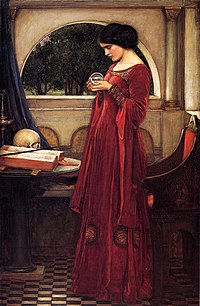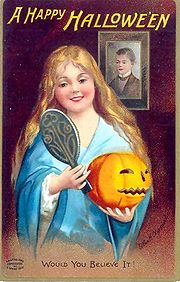Scrying
From Wikipedia, the free encyclopedia
- "Seer stone" redirects here. For the usage in Mormonism, see Seer stone (Latter Day Saints).

Scrying (also called crystal gazing, crystal seeing, seeing, or peeping) is a magic practice that involves seeing things psychically in a medium, usually for purposes of obtaining spiritual visions and more rarely for purposes of divination or fortune-telling. The media used are most commonly reflective, translucent, or luminescent substances such as crystals, stones, glass, mirrors, water, fire, or smoke. Scrying has been used in many cultures as a means of divining the past, present, or future. Depending on the culture and practice, the visions that come when one stares into the media are thought to come from God, spirits, the psychic mind, the devil, or the subconscious.
Although scrying is most commonly done with a crystal ball, it may also be performed using any smooth surface, such as a bowl of liquid, a pond, a crystal, or, as expert scryers can[citation needed], a thumbnail. Scrying is actively used by many cultures and belief systems and is not limited to one tradition or ideology. However, like other aspects of divination and parapsychology, it is not supported by mainstream science as a method of predicting the future or otherwise seeing events that are not physically observable.
Contents |
[edit] Method of scrying
The visions that scryers say they see may come from variations in the medium. If the medium is water (hydromancy), then the visions may come from the color, ebb and flow, or ripples produced by pebbles dropped in a pool. If the medium is a crystal ball, the visions may come from the tiny inclusions, web-like faults, or the cloudy glow within the ball under low light (e.g. candlelight).
One method of scrying using a crystal ball involves a self-induced trance. Initially, the medium serves as a focus for the attention, removing unwanted thoughts from the mind in the same way as a mantra. Once this stage is achieved, the scryer begins a free association with the perceived images suggested. The technique of deliberately looking for and declaring these initial images aloud, however trivial or irrelevant they may seem to the conscious mind, is done with the intent of deepening the trance state, wherein the scryer hears their own disassociated voice affirming what is seen within the concentrated state in a kind of feedback loop. This process culminates in the achievement of a final and desired end stage in which rich visual images and dramatic stories seem to be projected within the medium itself, or directly within the mind's eye of the scryer, like an inner movie. This overall process reputedly allows the scryer to "see" relevant events or images within the chosen medium.
There is a method of scrying similar to the crystal ball method mentioned above, called Hersue. Mostly a folk tale, Hersue is a type of scrying that involves no physical medium with which to gaze through. It is believed to involve entering a trance-like state of mind, concentrating solely on the face of the person whom you wish to spy on. It requires a strong memory and good concentration, as you will need to remember every detail of the person’s face, and nothing else. If properly performed, the result will be similar to astral projection. You will be in close proximity to your target, and will retain all five senses: sight, hearing, feeling, smell, and taste. It would be as if you were there in person, but you will not affect your surroundings in any way. You will not pass through objects, but if they are moving towards you, you will simply be moved out of the way during contact. Even a blade of grass will not bend from your weight, though air and other gases pass through your body without affecting you, or movement would become impossible while in this state. Due to the perfect memory required, and intense concentration needed, it has been said that humans can not possibly work this form of scrying. In the folk tale, this magic was used by vampire-like creatures called Legure to locate escaped prey.
[edit] Religion and mythology
[edit] Judaism and Christianity
According to the Hebrew Bible, Urim and Thummim (Variously translated from Hebrew as "Revelation and Truth" or "Lights and Perfections".) were used as a divination process. Many scholars believe they were two or twelve crystals used for scrying, but there are also other interpretations. The earliest reference is in Exodus 28:30, when Aaron carried them with him as High Priest.
[edit] Ancient Persia
The Shahnameh, a historical epic work written in the late 10th century, gives a description of what was called the Cup of Jamshid or Jaam-e Jam, used in pre-Islamic Persia, which was used by wizards and practitioners of the esoteric sciences for observing all the seven layers of the universe. The cup contained an elixir of immortality.
[edit] Mormonism
Joseph Smith, Jr., the founder of Mormonism and the Latter Day Saint movement, used magical stones (referred to in Mormonism as "seer stones") for various purposes. Scrying through magical stones was a common practice in Smith's early 19th century New England, and was practiced by several respected leaders at the time. During his life he had at least three separate stones that were obtained through various means (one of which he recovered by looking into a neighbor's seer stone and seeing the location). These stones were initially used in various treasure digging endeavors.[citation needed] Later, Smith used two stones called the Urim and Thummim, two clear stones in a bow that resembled spectacles, in his 1829 translation of the Book of Mormon from the Golden Plates (although much of the translation was actually done using one of the stones that he obtained earlier in life).[citation needed]
Though Smith initially used his stones to see hidden things, their use later evolved into a revelatory catalyst. Smith and others claimed that God communicated to them through these stones. Two stones, believed to be Urim and Thummims but referred to as "interpreters" are mentioned in the Book of Mormon. Smith claimed to have discovered this ancient scrying rocks by aid of an angel along with the Golden Plates.
Modern Mormons believe in the validity of Smith's claimed ability to have been able to use seer stones, along with the divine revelations that Smith claimed to have received through them.[citation needed]
[edit] In folklore

Rituals that involve many of the same acts as scrying in ceremonial magic are also preserved in folklore form. A formerly widespread tradition held that young women, gazing into a mirror in a darkened room (often on Hallowe'en) could catch a glimpse of their future husband's face in the mirror — or a skull personifying Death, if their fate was to die before they married.
Another form of the tale, involving the same actions of gazing into a mirror in a darkened room, is used as a supernatural dare in the tale of "Bloody Mary". Here, the motive is usually to test the adolescent gazers' mettle against a malevolent witch or ghost, in a ritual designed to allow the scryers' easy escape if the visions summoned prove too frightening.[1]
[edit] Modern uses
- The Dr. John Dee of the Mind research institute founded by the parapsychologist Raymond Moody utilizes crystallomancy to allow people to experience an altered state of consciousness with the intention of invoking apparitions of the dead.
- In the TV series Babylon 5, Telepath Alfred Bester uses a form of scrying in the episode The Corps is Mother, the Corps is Father.
- Contemporary mass media, such as films, often depict scrying using a crystal ball, stereotypically used by an old gypsy woman.
- In Christopher Paolini's fictional universe of Alagaësia (Eragon), magic users can use scrying through shiny objects to see things they have seen before.
- In J. R. R. Tolkien's fictional universe of Middle-earth (such as The Lord of the Rings), the Palantír is a stone that allows seeing what any other Palantír sees, and the Mirror of Galadriel is used as a type of scrying device used to see visions of the past, present, or future.
- In the television show Charmed the main characters use crystals suspended over maps to scry for people. This is different from other forms because it just shows location and not a picture, which leads many people to call this practice dowsing.
- A toy known as the 'Magic 8-Ball' which consists of a plastic ball filled with an inky solution that contains a buoyant icosahedron; each face of the icosahedron has different answers printed that appear to the 'consulter' through a small window when held upright. T.V. shows like Friends and the The Simpsons used this toy.
- 'Scry' was an ability used by the Scholar class in the online game 'Sock 2' at rpgamer.com, which allowed the caster to see the actions another contestant had taken that turn.
- A scryer named Snow is a character in the novel The Blood Confession. She foretells the future in mirrors and draws pictures of her prophetic dreams.
[edit] See also
[edit] Notes
- ^ Bill Ellis, Lucifer Ascending: The Occult in Folklore and Popular Culture (University of Kentucky, 2004). ISBN 0-8131-2289-9
[edit] References and further reading
- Scrying, A Short Course in
- Psychomanteum
- A Symbolic Representation of the Universe: Derived by Doctor John Dee Through the Scrying of Sir Edward Kelly ~Aleister Crowley, Adrian Axwirthy
- Crystal Gazing: Study in the History, Distribution, Theory and Practice of Scrying ~Theodore Besterman
- Scrying for Beginners: Tapping into the Supersensory Powers of Your Subconscious ~Donald Tyson
- Crystal Gazing: Its History and Practice with a Discussion on the Evidence for Telepathic Scrying ~Northcote W. Thomas
- Andrew Lang, Crystal visions, savage and civilised, The Making of Religion, Chapter V, Longmans, Green, and C°, London, New York and Bombay, 1900, pp. 83-104.
- Shepard, Leslie A. Encyclopedia of Occultism and Parapsychology. Gale Research, Inc.
- http://www.themystica.com/mystica/articles/c/captromancy_or_enoptromancy.html
- http://www.agnosticwitch.catcara.com/divindex-part1.htm
- Armand Delatte, La catoptromancie grecque et ses dérivés (1932)
- Scrying and Divination Methods
- Techniques and methods of Hydromancy
- http://skepdic.com/scrying.html


